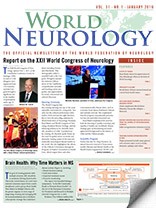By William M. Carroll, MD
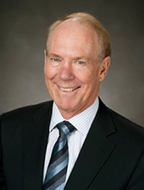
William M. Carroll
The XXII World Congress of Neurology opened Nov. 1, 2015, at the CasaPiedra Conference Center in Santiago, Chile. A total of 3,500 delegates were registered from 110 countries, and this Congress brought a significant rise in the number of participants under age 35 compared to those attending Vienna and Marrakesh. This demographic added a youthful look to the Congress. Delegates enjoyed the intimate Chilean décor of the CasaPiedra, comprehensive scientific and teaching course programs, and opportunities for social, educational and cultural discourse.
Opening Ceremony
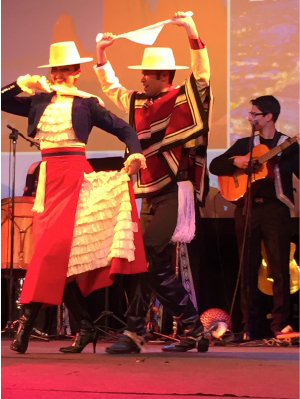
The XXII World Congress of Neurology opens with a lively Chilean cultural performance.
The World Congress Sunday evening opening was one of the most enjoyable ceremonies for a long time. Not only was the cultural performance informative, lively and just the right duration, but so were the preceding addresses by World Federation of Neurology President Raad Shakir and World Congress of Neurology President Renato Verdugo, and the following address by Dr. Michelle Bachelet, president of Chile. A pediatrician by training, Dr. Bachelet spoke firmly on the need for global action on stroke and dementia, leading causes of the noncommunicable neurological disease burden in the world. She also highlighted the efforts of the Chilean Government through its Program of Explicit Guarantees in Health Care, which targets these and other noncommunicable disease states, such as traumatic brain injury, Parkinson’s disease and multiple sclerosis. She emphasized that the program was primarily preventative but also provided structured care.
Raad Shakir emphasized the need for both the fostering of quality neurology and equality of health care worldwide, Renato Verdugo gave an illuminating and much appreciated background on the history of Chile and the Chilean peoples.
Scientific Program
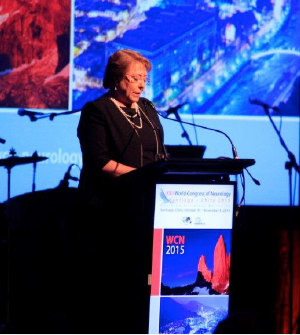
Michelle Bachelet, president of Chile, addresses the Congress.
Earlier that day, Dr. Oleg Chestnov, Assistant Director-General of Noncommunicable Diseases and Mental Health at the World Health Organization (WHO), led a WHO Symposium. A former gastroenterologist, his opening address was replete with illustrative and amusing anecdotes. Importantly, he highlighted the lack of neurologists as evidenced in the upcoming latest edition of the Atlas of Neurology (a joint WHO and WFN initiative), and the WHO Action Plan 2013–2017 concentrating on noncommunicable diseases. Dr Chestnov drew attention to the following points.
- Epilepsy is now a WHO Assembly agenda item where the goals are to strengthen effective leadership, improve provisioning of care, integrate epilepsy into primary health care services and increase access to medications.
- It is estimated that in 2015, 47 million people globally have dementia, and this figure will double every 20 years. The global cost in 2010 was estimated at $US604 billion.
- Finally, he acknowledged the importance of the First Ministerial Conference on Global Action Against Dementia held earlier this year.
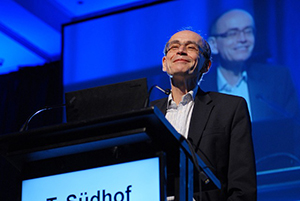
2013 Nobel Laureate in Physiology and Medicine Prof. Thomas Südhof presents a lecture on neurexins.
This important plenary session was completed by an authoritative review by Prof. Ingrid Scheffer of Melbourne, Australia, describing how genetics is influencing the management of epilepsy.
The scientific program was by all accounts one of the highlights of the meeting. Throughout, there were superb plenary lectures and symposia on all major neurological topics, providing clear insight into the robust pursuit of knowledge of basic science and its translation to clinical practice. It is only possible to mention a few of these.
Prof. Charlotte Cordonnier of Lille, France, addressed the vexatious issue of cerebral microhemorrhages and their relation to amyloid angiopathy, their management and risks with current stroke prophylaxis. Their investigation with the use of 7T Tesla to define stroke risk and new prospective studies defined lesser risks from ischaemic prophylaxis therapy for certain defined stratified groups.
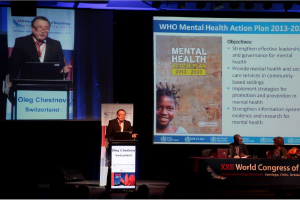
World Health Organization (WHO) Assistant Director-General of Noncommunicable Diseases and Mental Health Oleg Chestnov leads a WHO symposium.
Prof. Jes Olesen in presenting the Yahr Award Lecture reviewed the current state of headache research and treatment, describing the new version of the International Headache Classification, to be incorporated in ICD11, and then aspects of migraine. He drew attention to three monogenic loci for familial hemiplegic migraine. He contrasted this with the 42 loci identified in the International Headache Genetics Consortium Genome-Wide Association Study in common migraine, nine of which also affect gastrointestinal tract musculature. In reviewing treatment, he lamented the lack of medications to reduce migraine aura, especially tonabersat because of the high cost the effectiveness of the angiotensin-II receptor antagonist candesartan as prophylactic, the need for calcium gene related peptide monoclonal antibodies for chronic migraine and the development of headache centers to hasten research and its translation to clinical care.
Profs. Michael Brainin, Geoffrey Donnan and Nick Ward gave an overview of the long-term perspective in stroke, tackling early diagnosis, secondary prevention and brain recovery in a high-class exposition, respectively.
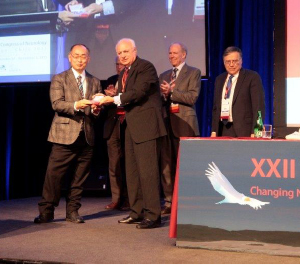
Prof. Shoji Tsuji receives recognition for scientific achievements from WFN President Raad Shakir.
Prof. Neil Scolding’s thoughtful and practical lecture on the role of cell therapy in central nervous system disorders was a useful update in this much-anticipated therapeutic approach. Dr. Jon Stone’s lecture on the identification and management of functional disorders also was a well-received review of the current state of this sometimes difficult to manage topic. This theme also was the basis for the excellent review given by Prof. Mark Hallett of the National Institutes of Health during the Victor and Clara Soriano Award Lecture. His talk combined the electrophysiological study of motor acts with the psychology of the perception of functional and normal movements. Prof. Giacomo Rizzolatti updated the conference on mirror mechanisms and their clinical relevance together with the essential role of mirror neurones in this concept.
Prof. Kazuo Fujihara from Sendai, Japan, reviewed the current state of understanding of neuromyelitis optica spectrum disorders, highlighted the relatively uniform worldwide prevalence of this condition, the recently published Consensus Diagnostic Criteria and the increasing role of AQP4 seropositivity in the diagnosis.
Prof. Alan Thompson, of the University College London, gave an impeccably balanced update on the current state of research and treatment, the global initiative in progressive multiple sclerosis and the recent report of the first large-scale phase III trial of early anti B-cell treatment to modify the disease course.
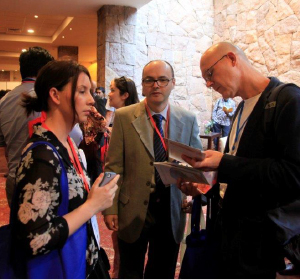
Delegates gather to share ideas during
the Congress.
Prof. Thomas Südhof, 2013 Nobel laureate in physiology or medicine, treated delegates to an enthralling lecture on “Neurexins and Company: Towards a Molecular Logic of Neural Circuits,” describing their role in the function and dysfunction of neural networks in schizophrenia, autism and intellectual disability.
On the last day, the final Tournament of the Minds was held. The final teams buzzed in for their first right to answer to a question with a penalty for an incorrect answer. It was contested by the United Kingdom, Australia and Japan, and finished in that order. Congratulations to the United Kingdom team, which finished well ahead of the scheduled time for the completion of this session. The tournaments was followed by the closing ceremony with the presentation of a gavel to Prof. Yoshikazu (Kaz) Ugawa, President of the XXIII World Congress of Neurology, from the XXII World Congress of Neurology President Renato Verdugo, in order to have the 2017 Congress called to order.
Summary
A total of 272 oral lectures, and 36 teaching courses with three or four lectures each were presented; 1,230 posters were displayed from 1,668 abstracts, and there were five satellite symposia.
There were four named lectures:
- Yahr Award Lecture: Prof. Jes Olesen, “New Concepts in headache”
- Victor and Clara Soriano Award Lecture: Prof. Mark Hallett, “The Physiology of Will”
- The Fulton Society Symposium-Soriano Award Lecture: Prof. Giacomo Rizzolatti, “The Mirror Mechanism and Its Clinical Relevance”
- Bharucha Award Lecture: Prof. Richard Hughes, “Guillain-Barré Syndrome and CIDP: One disease or Many?”
The World Federation of Neurology also presented medals to two distinguished recipients. The first was for Service to Neurology and was presented to Dr. Michel Dumas for services to the development of neurology in Africa and elsewhere. The second was awarded to Prof. Shoji Tsuji of Japan for scientific achievements in neurology. Dr. Gallo Diop, WFN trustee, and Prof. Roger Rosenberg, University of Texas Southwestern, read the citations, respectively.
Social Event Program and WFN Business
The welcome reception was held immediately after the opening ceremony and was well attended. The Chilean networking event was held out of the city at a well-known winery and was enjoyed by the participants, after they recovered from the long bus ride inflicted by the Santiago evening traffic rush.
At the World Federation of Neurology Council of Delegates meeting held Nov. 1, a number or reports were presented, elections held and votes taken. Among these was the tightest decision for a WCN venue so far. For the XXIV World Congress of Neurology in 2019, Dubai triumphed with the slimmest of margins over Cape Town. Either would have been a fitting site for the XXIV World Congress of Neurology, a likely reason for the closeness of the final result. Dr. Richard Stark was elected to the new position of treasurer allowing Prof. Wolfgang Grisold to have more time for the secretary general’s role. Dr. Morris Freidman of Canada defeated an exceptional field of candidates for the position of elected trustee. The WFN wishes these new members of its executive team an enjoyable and productive term.
An issue, which arose and caused the trustees and organizers considerable concern, was the procurement of visas for the Chile World Congress of Neurology. Many delegates were forced to go to extreme lengths to obtain a visa. A number were unable to complete this, and even some of those who did obtain a visa were restricted to the duration of the Congress. The Council of Delegates recognized the difficult circumstances members of many national societies found themselves in as a consequence of the large flows of migrants in many parts of the world. In the future, the World Federation of Neurology hopes not only to have those bidding for future venues to declare freedom from restricted access to them, but also to identify and forewarn delegates of any practical difficulties they may encounter. These items will be placed on the website well before each upcoming World Congress of Neurology.
Finally, at the Trustees Meeting held during the XXII World Congress of Neurology, the suggestion made at the Kyoto site visit in September 2015 to restrict the number of faculty members to just more than 200 was endorsed with twin aims. The first was to control the cost of the World Congress of Neurology, but also to move to full funding of faculty members. The World Federation of Neurology recognizes that the best calibre lecturers are in a competitive environment and that it must make the invitation to the World Congress of Neurology most desirable.
Conclusion
As the curtain closes on the XXII World Congress of Neurology in Santiago, Chile, we should remember the spirit of giving so generously displayed by the Chilean society, the high level of educational endeavor, the friendships made and renewed, and the scientific, topical and cultural discussions that are part of the intangible benefits we and our colleagues derive from the World Congress of Neurology as we look forward to the XXIII World Congress of Neurology in Kyoto in 2017.
